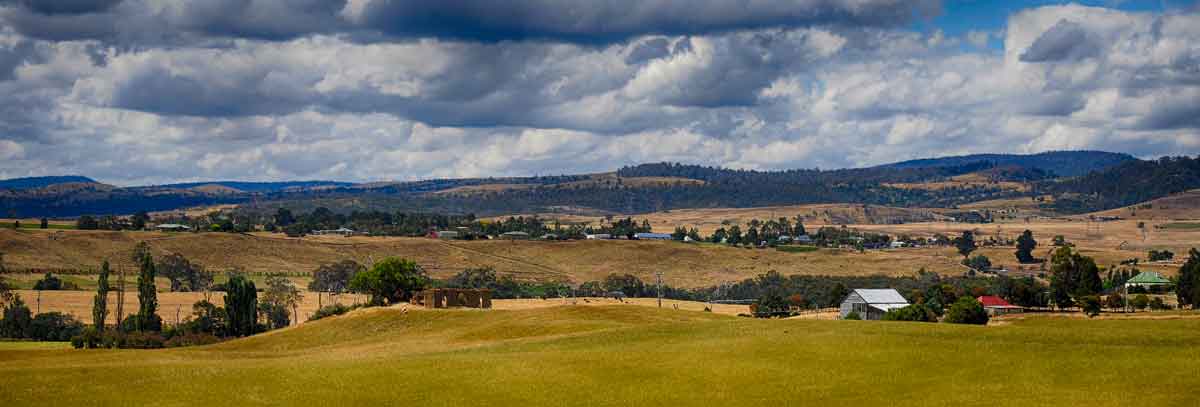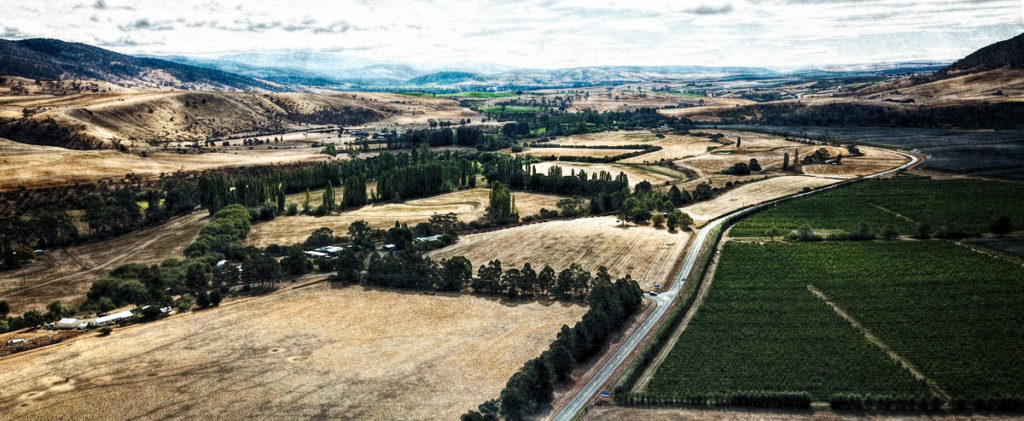The Derwent Valley is a colourful canvas of rich history, friendly people and rolling hills, often channeling the charisma of a lively French countryside. Located in southern Tasmania just a half hour drive north of Hobart, the iconic stunning valley features historical buildings, lush wilderness areas, bustling towns, thriving industries and countless stories from eras past. Often referred to by locals as the ‘Valley of Love’, the Derwent Valley occupies an area of 4,111 km² and has a population of around 10,000.

Noteable Features In The Derwent Valley
The Derwent River is the meandering lifeblood of the valley and provides valuable freshwater to agriculture, industry and leisure activities like kayaking and whitewater rafting. Originating at Lake St. Clair and flowing 239km southwards to Hobart, the river is fed by many tributaries and in some places contributes to Tasmania’s complex hydroelectric scheme. Trout and salmon hatcheries are scattered throughout the valley.
The town of New Norfolk is the ‘capital’ of the valley and is the hub of agricultural, tourism and commercial activity in the area. The town features a busy high-street, shops, schools and services for locals and visitors. New Norfolk is known as the ‘Antiques Capital of Tasmania’ and is home to Australia’s oldest mental hospital hosting fascinating convict and modern history.
New Norfolk contains historically significant buildings including St. Matthews Church (the oldest Anglican Church in Tasmania) and the Bush Inn (oldest continually licensed pub in Australia).
Agriculture is a widely practiced economic activity in the area due to a favorable climate, fertile soil and fresh water from the Derwent and her tributaries. Much of Australia’s hop output is grown in the valley, and for many years the Derwent was the most successful hop growing area in the Southern Hemisphere. Other agricultural industries include the growing of cherries, raspberries, blackcurrants, apples, poppies, cattle and sheep. The valley is a major supplier of livestock to the Australia and the world.
The Valley is home to Mt. Field National Park, one of the oldest protected wilderness areas in Australia. The National Park contains unique Tasmanian flora and fauna including rare species of native animals and some of the tallest trees in the world. The park is littered with lakes, snow capped mountain peaks in the colder months and stunning waterfalls including the Lady Barron Falls, the Horseshoe Falls and Russell Falls. The park offers numerous leisure activities such as walking, glow worm tours at night, skiing, caving and camping.
Exploring the Derwent Valley
The best way to explore the Derwent Valley is by car. Clearly signposted roads and highways are a breeze to navigate and much of the valley’s scenery can be casually explored and photographed in a day or two.
Redlands Distillery is a single malt whisky distillery located in Plenty, approximately ten minutes drive from New Norfolk. The picture-perfect distillery is one of two unique ‘paddock to bottle’ distilleries in the world where Redland’s skilful producers grow their own barley, draw their own water from a local source, malt their own barley and finally distil beautiful spirits in their circa 1857 granary building. Redlands offers visitors a range of experiences including tours of the distillery, whisky tastings and tours of the surrounding leafy gardens, historic oast house and colonial outbuildings. Learn more here.
The Salmon Ponds is a trout hatchery approximately ten minutes drive from New Norfolk at Plenty. The location provides over 1 million fish per year to Tasmanian lakes and dams and visitors have the opportunity to feed fish and walk amongst the grounds’ picturesque setting. If you are lucky you will see one of the two platypuses swimming around, sometimes not a meter from your feet. The location features a historical exhibit demonstrating the history of trout fishing in Tasmania and a renowned cafe offering sweet and savoury pancakes.
Towns In The Valley
Other notable locations to visit in the Derwent Valley include Granton, New Norfolk, Plenty, Bushy Park, Westerway, National Park, Maydena, Gretna, Hamilton, Ouse, Tarraleah, Derwent Bridge and Lake St Clair.
Granton – known for its vineyards and wineries and visitors can sample locally created wines at vineyards and cellar doors.
New Norfolk – The ‘capital’ of the valley.

Westerway – A small hamlet and home to the Westerway Rasberry Farm. Fresh raspberries can be purchased here in season. Food and fuel is available at the Westerway Roadhouse.
Plenty – Home of The Salmon Ponds and a massive orchard, Reid Fruits, growing cherries and apples for export and domestic markets.

Looking West from Plenty
Bushy Park – A small hamlet centred around the hop growing industry. Food and fuel is available here at the Bushy Park Roadhouse.
National Park – Mount Field National Park is accessed from here. A beautiful park offering camping, barbeque sites, walking, tours and after a short picturesque walk, the stunning Russell Falls. The Waterfall Cafe offers gifts and food.
Maydena – The last town before the wilderness that leads to Strathgordon. Attractions include the Railtrack Riders where you can ride a pedal driven carriage along the old logging railway and the Styx Big Tree Reserve, a stunning area deep in the Styx Forest.
Adamsfield is a deserted mining settlement hidden in the remote wilderness between Maydena and Strathgordon. Once the site of an Osmiridium mine, the site is now fading away with wood huts, scattered old mining equipment and fascinating period artifacts providing a window into the life and times of miners and bush-men of the early to middle 20th century. Adamsfield is only accessible by four wheel drive and with written permission (and access to a key to get through locked gates) from the Department of Parks & Wildlife.
Hayes – a small village on the Lyell Highway, just north of New Norfolk, is home to the Two Metre Tall Farmhouse Ale and Cider brewery open every Friday and Sunday – be very careful if you are driving!

Plenty looking towards New Norfolk and Mt Wellington
Hamilton is a thriving small township containing remarkable sandstone buildings, including St. Peter’s Church (1838), Emma’s Cottage (1830), Hamilton Inn (1834), Victoria’s Cottage (1845), George’s Cottage (1845) and the Glen Clyde House built in 1840 which now serves as a craft gallery. Curringa Farm just north of Hamilton on the Lyell Highway is an award winning sheep and cropping farm offering four star accommodation cottages and farm tours to see sheep shearing, working farm dogs, forest walks and river views. Pre-booking is essential.
Ouse – A small town near to the banks of the Derwent River, famous for the Chapel of St. John the Baptist behind the Ouse Pub. The stained glass windows of the church are amazing. A roadhouse with fuel and a supermarket are situated here.
Tarraleah – Once the place of a thriving township and community, built to support the development of Tasmania’s hydroelectric scheme. Most of the town was intentionally dismantled once the nearby hydroelectric infrastructure was built and for many years it became a ghost-town. Nowadays it is home to the Tarraleah Lodge offering luxury accommodation looking out over the Tasmanian Highlands. A restaurant offering an incredible menu, regularly changed, and for whisky lovers the “Lodge Library” offers over 100 varieties of the best whiskies. One of the highest golf courses in Tasmania is close by.
Derwent Bridge – a small town on the road to the Cradle Mountain – St. Clair National Park. Lake St. Clair is the deepest lake in Australia and is a hub of water sports including canoeing, kayaking and fishing. Especially beautiful is the accommodation at Pump House Point. Also situated at Derwent Bridge is “The Wall” where artist Greg Duncan is creating a sculptured story of the bushland of the Central Highlands of Tasmania…a must see.
History
The Derwent Valley is Tasmania’s third oldest settlement and was originally inhabited by the Midland Aborigines called the Big River People. The valley received its first batch of convicts in the late 1700s making it a birthplace of dramatic early Colonial settlement. In the early 1800s the population of the valley increased with the arrival of the first batch of settlers, mostly from Norfolk Island.
Explorers looking for dramatic stories should start in the valley’s capital of New Norfolk. Although the town was christened as Elizabeth Town after the wife of Governor Macquarie, the inhabitants changed it to New Norfolk to maintain a connection with their old hometown. A local hospital was set up in the 1820s to provide health services to the settlers and a place to care for those deemed ‘insane’. Progress and development in Derwent Valley was rapid and roads and a railway line were built to connect the valley to Hobart. European settlers cleared much of the dense forest along the banks of the Derwent River for the agriculture we see today.
The giant newsprint mill “Australian Newsprint Mills” (now Norske Skog) was established downstream from New Norfolk at Boyer, just before the second world war and provided a significant economic boost to New Norfolk and the valley. The mill contributed to the establishment of local community facilities like tennis courts and the Boyer Oval.
Visit The Derwent Valley
To experience Tasmania is to spend a day exploring the Derwent Valley in summer, winter, autumn or spring.
Learn more?








